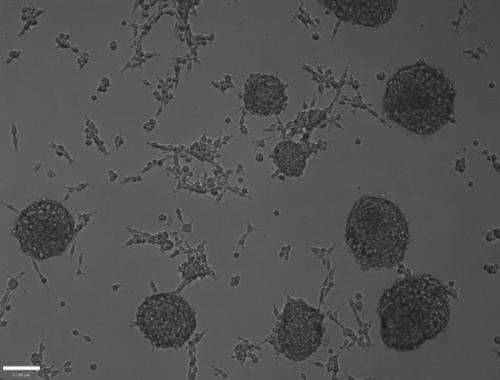It's all in the math: New tool provides roadmap for cell development

Researchers at Columbia University Medical Center have created a new tool to describe the many possible ways in which a cell may develop. Rooted in the mathematical field of topology, the tool provides a roadmap that offers detailed insight into how stem cells give rise to specialized cells.
The study was published today in Nature Biotechnology.
Every organism begins with one cell. As that cell divides, its copies branch off to become specialized cells—such as heart, bone, or brain cells—in a process known as differentiation. To understand the internal and external cues that move cells along this path, scientists can sequence their RNA—the molecular messenger that translates DNA into proteins and other products.
Sequencing RNA from a batch of cells is not ideal, however, because the cells are usually in different states of development. To address this problem, scientists have developed single-cell RNA sequencing. "It's like a new microscope, giving us the ability to study many biological phenomena at once," said Raul Rabadan, PhD, associate professor of systems biology and biomedical informatics at Columbia and co-author of the paper. "However, researchers are still left with the problem of understanding the relationships between different cell states, which drive the process of development."
To study cellular development, scientists use mathematical tools to analyze massive amounts of sequencing data. But these tools rely on underlying assumptions that narrow the possible results. "Due to the complexity involved in cellular development, models that make assumptions actually limit your ability to make new discoveries," said Abbas Rizvi, PhD, a postdoctoral research scientist in Columbia's Department of Biochemistry and Molecular Biophysics and the lead author of the paper.
Dr. Rizvi, together with Pablo G. Camara, PhD, a postdoctoral fellow and theoretical physicist in the Departments of Biomedical Informatics and Systems Biology, looked to topology, an area of math that studies the spatial relationships between surfaces and shapes, to identify connections between different cellular states and the genes that are active while cells are in those states. The collaboration developed an algorithm, called single-cell topological data analysis (scTDA). The algorithm analyzes the RNA sequences of individual cells, reconstructing the underlying developmental trajectories, and capturing the progression of different transcriptional programs in time.
The researchers used scTDA to map the path of mouse stem cells, which they had coaxed into becoming motor neuron cells. The map correctly indicated the possible developmental trajectory of these cells, starting as stem cells and finally becoming neurons. By looking at which genes were active near particular forks in the map, the researchers were able to identify proteins that appear to guide cellular development at different points along the path. The method was also applied to study the development paths of stem cells from mouse lungs, human embryos, and mouse brains.
"We expect many more discoveries to come to light as scientists mine this data set," said co-author Tom Maniatis, PhD, the Isidore S. Edelman Professor of Biochemistry, Chair of the Department of Biochemistry and Molecular Biophysics at Columbia. "It really opens up possibilities for a very deep analysis of individual cells at very specific stages of development," said Dr. Maniatis.
"This approach provides deep insights into the potential fate of a cell, giving us access to the pivotal regulators and molecular transitions that govern a cell's identity—and presenting the opportunity to steer cells away from paths that have a negative effect on its development," said Dr. Rizvi.
The approach is currently being applied to uncover the dynamics and cell makeup of complex biological processes, including cancer.
The paper is titled, "Single-cell topological RNA-Seq analysis reveals insights into cellular differentiation and development."
More information: Single-cell topological RNA-seq analysis reveals insights into cellular differentiation and development, Nature Biotechnology (2017). nature.com/articles/doi:10.1038/nbt.3854
Journal information: Nature Biotechnology
Provided by Columbia University Medical Center

















